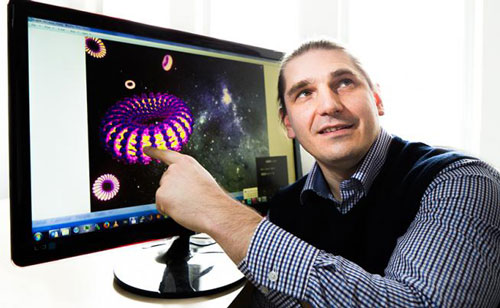| Posted: Aug 27, 2015 |
New theory leads to radiationless revolution
(Nanowerk News) Physicists have found a radical new way confine electromagnetic energy without it leaking away, akin to throwing a pebble into a pond with no splash.
|
|
The theory could have broad ranging applications from explaining dark matter to combating energy losses in future technologies.
|
|
However, it appears to contradict a fundamental tenet of electrodynamics, that accelerated charges create electromagnetic radiation, said lead researcher Dr Andrey Miroshnichenko from The Australian National University (ANU).
|
|
"This problem has puzzled many people. It took us a year to get this concept clear in our heads," said Dr Miroshnichenko, from the ANU Research School of Physics and Engineering.
|
 |
| Dr. Miroshnichenko with his visualization of anapoles as dark matter.
|
|
The fundamental new theory could be used in quantum computers, lead to new laser technology and may even hold the key to understanding how matter itself hangs together.
|
|
"Ever since the beginning of quantum mechanics people have been looking for a configuration which could explain the stability of atoms and why orbiting electrons do not radiate," Dr Miroshnichenko said.
|
|
The absence of radiation is the result of the current being divided between two different components, a conventional electric dipole and a toroidal dipole (associated with poloidal current configuration), which produce identical fields at a distance.
|
|
If these two configurations are out of phase then the radiation will be cancelled out, even though the electromagnetic fields are non-zero in the area close to the currents.
|
|
Dr Miroshnichenko, in collaboration with colleagues from Germany and Singapore, successfully tested his new theory with a single silicon nanodiscs between 160 and 310 nanometres in diameter and 50 nanometres high, which he was able to make effectively invisible by cancelling the disc's scattering of visible light.
|
|
This type of excitation is known as an anapole (from the Greek, 'without poles').
|
|
Dr Miroshnichenko's insight came while trying to reconcile differences between two different mathematical descriptions of radiation; one based on Cartesian multipoles and the other on vector spherical harmonics used in a Mie basis set.
|
|
"The two gave different answers, and they shouldn't. Eventually we realised the Cartesian description was missing the toroidal components," Dr Miroshnichenko said.
|
|
"We realised that these toroidal components were not just a correction, they could be a very significant factor."
|
|
Dr Miroshnichenko said the confined energy of anapoles could be important in the development of tiny lasers on the surface of materials, called spasers, and also in the creation of efficient X-ray lasers by high-order harmonic generation.
|

